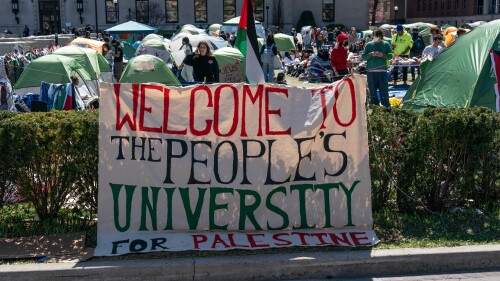Bahar Davary, an Iranian-American associate professor of theology and religious studies at the University of San Diego, doth protest far too much.
The good professor blithely ignores readily discernible contemporary U.S. trends, i.e., FBI data that for over a decade have consistently shown that anti-Semitic “hate crimes” occur at least five times more often than alleged “anti-Muslim hate crimes.” A purported “scholar,” Davary compounds this offense by heinously expropriating the Nazi yellow Star of David, imposed upon Jews in Hitler’s Germany, as part of an orchestrated “silent protest” with some 100 students and faculty donning yellow stars enclosing a crescent moon and marked “Muslim.”
Davary opined:
“Made to be the other,” by Islam, indeed. At least 1100 years before the Nazi era, Jews -- and other non-Muslims -- were victimized by aggressive jihad wars which expropriated their lands and replaced their governing systems with Sharia. Those who survived these mass murderous conquests were subjugated under the Sharia, per Koran 9:29, and “humbled/subjected/brought low.” Perhaps the clearest outward manifestations of this mandated, “sacralized” inferiority of the vanquished non-Muslim “dhimmis” (per the “dhimma,” or “pact” of submission, violated on pain of death by renewed jihad) were the prohibitions regarding dhimmi dress codes and the demands that distinguishing signs be placed on the entrances of dhimmi houses.
During the Abbasid Caliphates of Harun al-Rashid (r. 786-809 A.D.) and al-Mutawwakil (r. 847-861 A.D.), Jews (and Christians) were required to wear yellow patches attached to their garments. Subsequently, to differentiate further between Christians and Jews, the Christians were required to wear blue.
In 850, consistent with Koranic verses associating them with Satan and Hell (5:72;16:63; 58:19), al-Mutawwakil decreed that Jews and Christians attach wooden images of devils to the doors of their homes to distinguish them from the homes of Muslims.
But of especial relevance to Iranian-American professor Davary’s morally cretinous hypocrisy are the practices of Shiite Iran, which extended into the modern era. From the advent of the Iranian Shiite theocracy in 1501, the profoundly influential Shi’ite clerical elite have emphasized the notion of the spiritual and physical uncleanliness (najis) of Jews in particular, but also of Christians, Zoroastrians, and others as the cornerstone of inter-confessional relationships towards Iran’s non-Muslims. Non-Muslims’ spiritual impurity was linked in concrete and indelible ways to their physical impurity.
Professor Laurence Loeb’s seminal 1977 analysis of dhimmi Jews in Shiiite Persia/Iran documented the social impact of najis regulations, beginning with the implementation of:
With regard to dress, specifically, the stipulations of Al-Majlisi (d. 1699) -- the Ayatollah Khomeini of his era, and most influential Shiite cleric of the Safavid theocracy in Persia -- from his late 17th century treatise on non-Muslims (revealingly entitled, “Lightning Bolts Against the Jews”), are consistent with these millennial trends:
A compilation of late 19th through early 20th century American diplomatic actions (and related correspondence) affecting the Jews independently confirms the prevailing conditions for Persian Jews, which persisted over the intervening three centuries and included the odious imposition of najis-inspired “Jew-badging” in Iran:
Following a relatively brief hiatus under the Pahlavi reign (marked by efforts at both secularization and pre-Islamic revival from 1925-1979), the Khomeini-inspiredrestoration of a Shi’ite theocracy in Iran has been accompanied, predictably, by a revival of najis regulations.
Ayatollah Khomeini stated explicitly: “Non-Muslims of any religion or creed are najis.” The so-called reformist Green Movement’s spiritual leader, Iranian Ayatollah Hossein-Ali Montazeri (d. 2009), further elaborated that a non-Muslim’s (kafir’s) impurity was “a political order from Islam and must be adhered to by the followers of Islam, and the goal [was] to promote general hatred toward those who are outside Muslim circles.”
This “hatred” was to assure that Muslims would not succumb to corrupt, i.e., non-Islamic, thoughts.
The dehumanizing practical impact of najis regulations was again observable at points of contact between Muslims and non-Muslims -- wherever non-Muslims owned or operated businesses or manufacturing facilities whose personnel or products might “pollute” Muslims. For example (see this), shops that sold sandwiches or bakery goods (foodstuffs associated with minorities) were forced to display signs stating “especially for minorities.”
Eliz Sanasarian’s important study of Iranian non-Muslim religious minorities during the first two decades after 1979 provides a striking illustration of the practical impact of this renewed najis consciousness:
Thus, if formal badging requirements for Iran’s non-Muslims were ever re-implemented, these measures would simply mark the further retrogression of Iran’s non-Muslim religious minorities, completing in full their descent to a pre-1925 status.
Professor Davary’s reprehensible campaign wantonly negates this ongoing, chronic Jewish and broader non-Muslim oppression under Islam while cynically expropriating Holocaust symbolism. Her revolting actions are abetted by the ignorance, sheer stupidity, and moral turpitude of our sorry media, academic, political, and religious elites.



